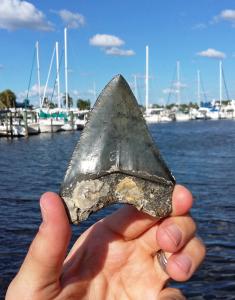My favorite hobby is SCUBA diving for fossils, particularly the giant teeth of megalodon sharks. In fact, I began diving several years ago to feed this fascination, which was sparked in my childhood when I discovered a shark tooth in my parents’ driveway. I was reminded while indulging this hobby, on a fossil dive yesterday, thirty feet under the Gulf of Mexico, why design is so unmistakable, and naturalistic evolution so untenable.
I dive several different locations for megalodon teeth, one of which is the fossil-rich zone just offshore from Venice and Sarasota, Florida. Due to the geography and weather of the region, sand rows form on the sea floor, running roughly north to south. These rows can parallel each other and run for hundreds of yards, and are regenerated by strong currents and wave action during storms. They’re a convenient natural topography, crucial for exposing fossils from the clay and matrix layers beneath the sand. Without them, sand and silt would quickly bury the ancient teeth, tusks, ribs, and other remains, making them inaccessible to divers. The rows also make keeping track of direction and location easier.

There’s a problem, however: When six to eight divers roll off the boat and descend to the sand rows after a storm, it’s easy to end up covering the same ground twice, unknowingly following another diver in the same row, where he or she has already gathered all the visible fossils. That’s a waste of air and bottom time. And since visibility is often limited, it’s easy to be within ten or fifteen feet of another diver and not see him or her. So, divers have developed a solution: at the end of each sand row, a diver will place a fossilized bone, a seashell, or a bit of coral upright in the sand, to let everyone know that row has already been searched. Some even draw a smiley face in the silt (though that may fade quickly).
Yesterday I did a lot of swimming between sand rows, so these markers came in handy. If I found a row without a marker, I knew it had not been searched yet, which made it prime territory for uncovering megalodon teeth. If it had a whelk or a shard of bone sticking out vertically, I inferred that someone had been there already, and moved on. This simple system for exchanging information underwater makes the whole day better and more productive for everyone.
But it also raises an interesting question–one I actually contemplated during the four or so quiet hours I spent yesterday scanning the bottom for fossils: How do divers know that each shell, bone, or smiley face felicitously perched or engraved in the sand rows wasn’t put there by natural processes, the way the sand rows themselves are produced? Why do we see the sand rows, running north to south with uncanny consistency, and (rightly) conclude that these are the product of waves rolling toward Florida’s west coast, yet see the shells, bones, and drawings at the ends of those rows and (rightly) conclude that they are a message from another diver? After all, it is conceivable that shells and bones could be positioned this way by the same forces that produced the sand rows. It’s even possible (in theory, given enough time), that the currents and tide could produce a smiley face or two in the silt.
How do we distinguish actual order from order that is merely apparent, or unintentional? The answer is William Dembski’s concept of specified complexity, which is nicely summarized here. To put it in terms of my own experience, there are two crucial features by which we recognize information, or infer intelligent agency (in this case, a diver setting up shells). The first is complexity. This means a given arrangement of parts is unlikely to have come about by chance. So, a shell standing vertically at the end of each sand row is a highly unlikely pattern for natural processes to produce. Theoretically, they could. But mathematically, the odds against it are astronomical.
However, the odds against shells arranged vertically in any other pattern are also astronomical. A shell at the end of each row, for fifty rows, is roughly as likely as the same number of shells arranged to form the words “SHANE WAS HERE.” Neither, by itself, is information. That’s where the second criterion, specificity, comes in. The reason anyone would recognize words spelled with shells, let alone the exact words, “SHANE WAS HERE,” is that words are specific. We have a pre-existing, independent idea in our minds of what words are, and a system by which they convey meaning. When we see words formed in a meaningful way, even by natural objects that are as likely to have been flung into that pattern as any other specific pattern, we immediately recognize intelligent agency.
This holds true even for patterns that are less initially impressive than a worded message. If you found shells sticking up at the end of sand rows, you might be able to shrug it off as a byproduct of wave action, as the sand rows themselves are. But if you were on the dive boat where eight people specified ahead of time that this would serve as a form of communication, you would think differently. You would recognize the specified complexity in those shells sticking up from the bottom of the ocean.
This method is so reliable that it is virtually impossible for it to produce false positives on the level of human language. In the history of the world, there are no examples of natural processes producing a three-word sentence. And the DNA molecule is several orders of magnitude more complex than even a long sentence.
One of the common criticisms of intelligent design theory is that it employs a “God-of-the-gaps” argument, e.g., “We don’t know how this biological language could have been produced by natural processes, therefore God did it.” And this sort of argument is certainly fallacious. In times past, people attributed thunder to brawling deities. Now we know that it’s a shock wave caused by the expansion of plasma in the lightning channel.
But as intelligent design proponent Dr. Stephen Meyer argues here, recognizing complex specified information in biology is not only logically sound, but it is the type of inference we rightly make whenever we see information, no matter where it is encoded. It is the prevailing prejudice against intelligent causation in biology, not sound thinking, that keeps us from drawing this valid inference when it comes to the language of life. Recognizing a mind behind the digital code that produces every organism is not a “God-of-the-gaps” argument, any more than recognizing the words “SHANE WAS HERE” written in shells as a sentence is a SCUBA-diver-of-the-gaps argument.












